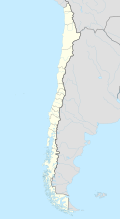Ancud
Ancud is a city in southern Chile . It is located on Chiloé , the second largest island in the country, and has a population of 28,265 (2017).
geography
The city is located on the Chacao Canal in the north of Chiloé. The Panamericana runs through them . The prevailing climate there is mild but extremely humid. Rain is extremely frequent, with an annual fall of 2035 mm.
history
The Huilliche people lived on Chiloé before the Spaniards . In 1540 Alonso de Camargo explored the island's coastlines from a ship. The island was first set foot on November 8, 1553 by Francisco de Ulloa .
On August 20, 1768, Ancud was founded by Governor Carlos de Berengue as "San Carlos" and expanded by the Spanish as a fortress to control shipping to and from Cape Horn. In 1787, the Camino de Caícumeo was the first land connection to Castro , 88 km away , and in the first town fire in 1794, numerous buildings near the fortress fell victim to the flames. In 1788 Ancud became the capital of the province and the island of Chiloé.
The city remained in Spanish hands long after Chilean independence. She was attacked in 1820 by Lord Cochrane and in 1824 by General Freire in vain. In January 1826, Chilean troops captured the city of Ancud from the Spaniards on Freire's second attempt.
In 1840 Ancud became a bishopric.
On September 21, 1843, the brig Ancud traveled from Ancud to southern Chile for the purpose of annexing the southern areas around the Strait of Magellan . The trip was led by John Williams Wilson , accompanied by Bernhard Eunom Philippi Krumwiede , who later also organized the settlement around Puerto Montt with German immigrants. In 1879, 500 houses, the cathedral and all administrative buildings fell victim to another city fire. In 1895, with the arrival of seven families from Germany, the German settlement of the area began.
The new cathedral was inaugurated on January 1, 1900, and in 1912 the 88 km long railway line to Castro. In 1924 the city had 4,295 inhabitants and had 8 primary schools, a German high school ( Colegio alemán ) and a vocational school, and in 1926 the Chilean writer Pablo Neruda lived in Ancud. With the commissioning of the railway line from Santiago de Chile to Puerto Montt (1905) and the opening of the Panama Canal (1914), the economic importance of the city declined considerably after it unified Chiloé at the end of the 19th century thanks to the development of forestry and wood processing had taken a significant upswing.
On May 22nd, 1960, Ancud was badly damaged by a severe earthquake followed by a tsunami . The earthquake fell victim to the cathedral, which was later rebuilt in a smaller form, as well as the train station and the railway line to Castro.
Ancud was the capital of Chiloés from 1788, but had to cede this position to the city of Castro in 1982.
economy
Ancud lives mainly from tourism, fishing and agriculture.
Attractions
- The old Spanish fortress Fuerte San Antonio , built in 1770, is a popular tourist destination with its cannons and beautiful views of the city. The Spanish flag flied on it until January 19, 1826.
- In the "Museo Regional Aurelio Bòrquez Canobra" you can explore the history of the city. In the courtyard of the museum you can see a replica of the ship "Ancud", which started in 1843 from Ancud to the Strait of Magellan .
- The cathedral in Plaza de Armas, which was rebuilt in a reduced form after it was destroyed by the earthquake in 1960, is the seat of the Diocese of Ancud.
- On the Plaza de Armas, the lively main square of the city, there is a monument to the firefighters in addition to well-tended green areas and a bandstand. The city administration building ( Municipalidad ) is also located in the plaza . The very lively Calle Pudeto, the city's main shopping street, leads from the plaza past the market hall, which is also worth a visit, to the port and the promenade.
- Also worth a visit is the Avenida Salvador Allende promenade with several monuments and well-tended green spaces. From here there is a beautiful view of the city and its surroundings.
- The Iglesia San Francisco church is worth a visit on Calle F. Errázuriz .
Surroundings
Many seabirds can be seen on the coast and in the fjords .
The small town of Punihuil is known for its colony of Humboldt penguins . On the small offshore islands of Islotes de Punihuil , which cover a total of 8.64 hectares, Magellanic and Humboldt penguins nest from mid-September to mid-March.
The Fuerte Ahui fortress , now in ruins, was built in 1779 and expanded in 1796. It was used until 1826. In it are z. B. received the powder magazine and 14 cannons.
See also
Individual evidence
- ↑ Juan Mancilla Pérez: Pueblos de Chiloé. Castro 2008, p. 10.
- ↑ Juan Mancilla Pérez: Pueblos de Chiloé. Castro 2008, p. 11.
- ↑ Dominique Verhasselt: Archipielago Chiloé - el encanto de una isla misteriosa. Santiago de Chile around 2001, ISBN 956-7136-53-X , p. 13.
- ^ Jorge Sánchez R .: Chiloé - tradición y cultura. Santiago de Chile 2006, ISBN 956-309-024-1 , p. 23.
- ↑ Dominique Verhasselt: Archipielago Chiloé - el encanto de una isla misteriosa. Santiago de Chile around 2001, ISBN 956-7136-53-X , p. 100.
- ^ Jorge Sánchez R .: Chiloé - tradición y cultura. Santiago de Chile 2006, ISBN 956-309-024-1 , p. 29.
Web links
Coordinates: 41 ° 52 ′ S , 73 ° 49 ′ W






